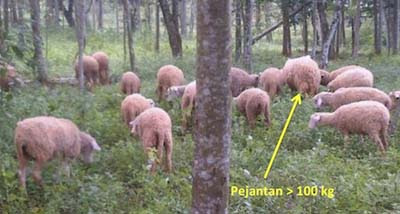"Eat and graze your animals. Verily in this, there are signs of the power of Allah for those who understand "(Qur'an, 20:54)
"Muslims are syirkah (sharia business cooperation) to three things, in terms of pasture (land), water and fire (energy)". (HR. Sunan Abu Daud).
Farmers outside Java island generally have 5-10 hectares of land, but not a few that have tens of hectares to hundreds of hectares. Many of these lands have not been planted or optimized so as to provide benefits for their owners. These lands are very potential to be made efficient pasture by rotating grazing. Sheep grazing and mixed sheep and cattle can be cultivated in these areas. Rotation grazing is to divide the pasture into several units such as the horse training arena (paddock), and then the cattle take turns grazing in the boundary grazing area. In rotation grazing there is always a pasture field that is rested to restore the growth of the grass. The landowners can also be syirkah (sharia business cooperation) to reach a certain area of land to be used as an energy plantation. Energy plantation will produce wood for energy, namely wood pellets or wood briquettes or derivatives of other products. The leaves are used for animal feed namely sheep and sheep with cow. Farm animals can even be grazed in an energy plantation area with certain techniques or sacrifice some land for grazing areas.
Rotation grazing will provide efficient results in both meat productivity and the sustainability of the pasture. Grass growth can be maintained in such a way by rotating grazing, which is maintained at height of 8-10 cm. If the grass is eaten out (overgrazed) to the base of the stem it will be difficult to grow properly again. The technique regulates that the grass continues to grow well by regulating the duration of grazing on the grazing block, this will also be affected by the season factor. Grass will grow faster in the rainy season and oppositely in the dry season. With good irrigation, the growth of grass in the dry season can be maintained. Pasture is essentially farming of grass itself. In addition, by rotation grazing of sheep or livestock, they will graze more evenly because the grazing area is limited by the barriers. As a comparison, continuous grazing is used, where animals tend to only eat grass that is preferred and even overgrazed so that the sustainability of grass pasture is less optimal.
Then how can the sustainability of pasture be optimal? Fertilization is an important thing to achieve this, in addition to the things above. Distribution of livestock manure must be made as well as possible in the pasture field. With a ratio of land area compared to the number of animals small or the number of livestock made more so that the larger population makes the distribution of fertilizer evenly distributed. The distance of livestock mobility in this way is short and limited. Of course the availability of feed in the form of grass is an important consideration for the technique. Dense grass, although not so broad, may provide more food than large land with rare grass populations. If the area of 1 m2 with the condition of dense grass produced 1 kg of grass, then for every hectare there is 10 tons of grass for feed.
The Qur'an shows that pasture animals like the shade under the trees and also near the source of water (QS 16:10). This has also been proven from professional grazing in various countries over the globe. For this reason the pasture should also be overgrown with trees like the Qur'an's instructions. Among these trees can also grow a lot of grass. Farm animals will spend a lot of time in the shade under the trees. Water sources also need to be provided at that location for the place to drink the grazing animals. As a result, livestock manure will also accumulate in these locations so that it also fertilizes the soil. Fruit trees and woody trees can be used in the pasture. Leaves from the energy plantation can be used as additional feed for the sheep. Sheep farming can also include supporting the Shari'a qurban ie Islamic Shari'a slaughtering sacrificial animals on every 10 Dzulhijah or Idhu Adha feasts. In addition to these lands being used for energy plantations, plantation lands in Indonesia is very broad, for example palm oil which reaches 12 million hectares, coconut 3.7 million hectares, rubber 3.5 million hectares, various fruit plantations also very broad can be modified by sheep grazing to optimize land and increase soil fertility.









No comments:
Post a Comment